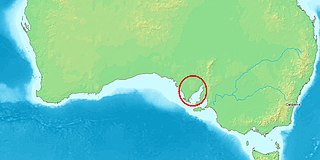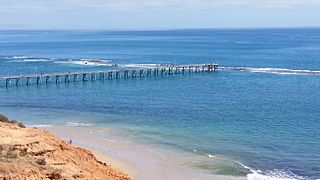Related Research Articles

Protected areas of South Australia consists of protected areas located within South Australia and its immediate onshore waters and which are managed by South Australian Government agencies. As of March 2018, South Australia contains 359 separate protected areas declared under the National Parks and Wildlife Act 1972, the Crown Land Management Act 2009 and the Wilderness Protection Act 1992 which have a total land area of 211,387.48 km2 (81,617.16 sq mi) or 21.5% of the state's area.

The Spencer Gulf is the westernmost and larger of two large inlets on the southern coast of Australia, in the state of South Australia, facing the Great Australian Bight. It spans from the Cape Catastrophe and Eyre Peninsula in the west to Cape Spencer and Yorke Peninsula in the east.
The New South Wales Department of Primary Industries (DPI) is an agency of the New South Wales Government, responsible for the administration and development for agriculture, fisheries, aquaculture, forestry, and biosecurity in New South Wales. The DPI works to drive innovation in primary industries to improve resilience, productivity and sustainability, and to ensure risks are managed for natural resources, farming and food.

Urrbrae is a suburb of Adelaide, South Australia. It is located in the City of Mitcham.
The South Australian Research and Development Institute (SARDI) is the principal research institute of the Government of South Australia, with a network of research centres, laboratories and field sites both in metropolitan Adelaide and throughout South Australia. SARDI is part of Primary Industries and Regions SA.

Torrens Island is an island in the Australian state of South Australia located in the Adelaide metropolitan area in the Port River Estuary about 15 kilometres (9.3 mi) northwest of the Adelaide city centre. Since European settlement of Adelaide in 1836, it has been used for a number of purposes.
National biosecurity in Australia is governed and administered by two federal government departments, the Department of Health and the Department of Agriculture, Fisheries and Forestry. The Biosecurity Act 2015 (C'wealth) and related legislation is administered by the two departments and manages biosecurity risks at the national border. The Act aims to manage biosecurity risks to human health, agriculture, native flora and fauna and the environment. It also covers Australia's international rights and obligations, and lists specific diseases which are contagious and capable of causing severe harm to human health. Each state and territory has additional legislation and protocols to cover biosecurity in their jurisdiction (post-border) including the detection of pests and diseases that have breached the national border.
The Department of Agriculture and Fisheries is a department of the Queensland Government which aims to maximise the economic potential for Queensland's primary industries on a sustainable basis through strategic industrial development. The section known as Biosecurity Queensland is responsible for biosecurity matters within the state.

West Island is a 10 hectares granite island lying 0.8 kilometres off the southern coast of the Fleurieu Peninsula, South Australia, 7 kilometres south-west of the town of Victor Harbor. It rises to a maximum height of about 40 metres in the south-west. Its main conservation value lies in its seabird colonies.

Pelican Lagoon Conservation Park is a protected area located in the Australian state of South Australia on the Dudley Peninsula on Kangaroo Island. It was dedicated in 1967 for the protection of wildlife habitat.

Paul Sinclair Heithersay is a public servant employed by the Government of South Australia. He is the chief executive of the Department for Energy and Mining. He was appointed to this role by the then recently elected Liberal government in June 2018.
The Resources Industry Development Board (RIDB) was formed in 2000 to enhance the growth of the state of South Australia's mineral and petroleum resources sector and its contribution to the state's economy. It was formed in response to recommendations of the Resources Task Force made the previous year. The RIDB provided advice to the Minister for Mineral Resources and Energy and the state government. There was a high degree of inter-activity with the Primary Industries and Regions SA (PIRSA) Division of Minerals and Energy which also provided the Board's secretariat.

Port Noarlunga Reef Aquatic Reserve is a marine protected area in the Australian state of South Australia located in waters in Gulf St Vincent adjoining the Adelaide metropolitan area and including part of the Onkaparinga River about 28 kilometres (17 mi) south-west of the state capital of Adelaide.
The Aquaculture Advisory Committee (AAC) was established by the Government of South Australia to support the development of the aquaculture sector in the state- the birthplace of Southern bluefin tuna ranching. Its role was to provide relevant advice to the Minister regarding the administration of the Aquaculture Act 2001, related policies, proposals, regulations and any amendments to them. In 2012, Fisheries Minister Gail Gago described the AAC as playing "a vital role in informing and advising Government to ensure the ecological sustainable development of South Australia’s world-leading aquaculture." In September 2014 it was recommended that the council be abolished in favour of direct sectoral representation.

American River Aquatic Reserve was a marine protected area in the Australian state of South Australia located on the north coast of Kangaroo Island in waters of the coastal lagoon known as Pelican Lagoon, in existence from 1971 to 2016. From 2012, the Pelican Lagoon Sanctuary Zone has fallen within the Encounter Marine Park. Pelican Lagoon is probably the oldest marine protected area in South Australia, having been protected since 1914.
Barker Inlet – St Kilda Aquatic Reserve is a marine protected area in the Australian state of South Australia located in waters adjoining the east coast of Gulf St Vincent in Barker Inlet about 16 kilometres (9.9 mi) north of the state capital of Adelaide.
Rob Lewis is a South Australian marine scientist and retired senior civil servant. He discovered the first known upwelling system in southern Australia and was professionally involved in fisheries and aquaculture management for 38 years. He was head of South Australian Research and Development Institute (SARDI) from 1992 to 2010.
The Australian Department of Agriculture, Water and the Environment (DAWE) was an Australian Government department which operated from 1 February 2020 until 30 June 2022. It represented Australia's national interests in agriculture, water and the environment.
References
- ↑ "Department of Primary Industries and Regions". SA.GOV.AU. 29 January 2019. Retrieved 26 March 2020.
- 1 2 "About us". PIRSA. 8 October 2014. Retrieved 24 March 2020.
- 1 2 Spence, Andrew; Anderson, Elizabeth (16 August 2019). "PIRSA, SARDI partnership with University of Adelaide helps dryland innovation". Stock Journal. Retrieved 26 March 2020.
- ↑ "New Chief Executive for PIRSA". Mirage News (in German). 10 March 2020. Retrieved 26 March 2020.
- ↑ Robinson, Tom (3 December 2019). "State Govt CEO "welcome to reapply" for his own job". InDaily. Retrieved 26 March 2020.
- ↑ "Primary Industries". PIRSA. 12 August 2014. Retrieved 24 March 2020.
- ↑ "Biosecurity". PIRSA. 12 August 2014. Retrieved 24 March 2020.
- ↑ "Growth State - Food, Wine and Agribusiness". PIRSA. 12 August 2014. Retrieved 24 March 2020.
- ↑ "Fishing". PIRSA. 12 August 2014. Retrieved 26 March 2020.
- 1 2 "Men fined for disobeying Fisheries Officer". Adelaide Now. 7 September 2015. Retrieved 26 March 2020.
- ↑ "Primary Industries and Regions SA (PIRSA) Grants Programs". GRANTassist Business. Retrieved 26 March 2020.
- ↑ "About SARDI". PIRSA. 12 August 2014. Retrieved 24 March 2020.
- ↑ "Primary Industries South Australia - Full view". Libraries Australia Search. Retrieved 26 March 2020.
- ↑ "Mines and Energy Resources South Australia - Full record view". Libraries Australia Search. Retrieved 26 March 2020.
- 1 2 3 "Primary Industries and Resources SA - Full view". Libraries Australia Search. Retrieved 25 March 2020.
- ↑ "Home". Department of Primary Industries and Regions South Australia. Archived from the original on 4 July 2007.
- ↑ "Pastoral Board Moves to PIRSA - Natural Resources SA Arid Lands". Select a region - Natural Resources South Australia. 9 May 2019. Retrieved 26 March 2020.
- ↑ "Pastoral leases in South Australia". PIRSA. 5 February 2019. Retrieved 26 March 2020.
- ↑ "Developing a new Biosecurity Act for South Australia (SA)". PIRSA. 8 April 2019. Retrieved 27 March 2020.
- ↑ "Fact Sheet -Biosecurity Legislation Project" (PDF). PIRSA. 13 March 2020. Retrieved 27 March 2020.>
- ↑ "Frequently Asked Questions: Biosecurity Act" (PDF). PIRSA. July 2019. Retrieved 27 March 2020.>
- ↑ "South Australia's Biosecurity Policy 2020–2023" (PDF). PIRSA. 2020. Retrieved 27 March 2020.>
- ↑ "Community Programs: Primary Industries and Resources SA". DPTI. Retrieved 26 March 2020.
- ↑ "PIRSA assesses bushfire livestock, viticulture impact". Stock Journal. 24 December 2019. Retrieved 26 March 2020.
- ↑ "Government". SA.GOV.AU. 28 January 2020. Retrieved 25 March 2020.